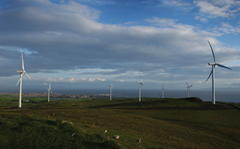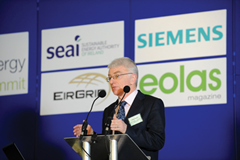The regulatory outlook for renewable energy
 Overcoming the volatility of wind energy will be the biggest challenge in meeting the 2020 renewables target, according to CER’s Denis Cagney. Meadhbh Monahan reports.
Overcoming the volatility of wind energy will be the biggest challenge in meeting the 2020 renewables target, according to CER’s Denis Cagney. Meadhbh Monahan reports.
The changes in the Irish energy landscape over the last decade have been “quite dramatic” according to Denis Cagney, the Commission for Energy Regulation’s Director of Gas and Legal Affairs.
Speaking to delegates at the 2011 Irish Renewable Energy Summit earlier this year, Cagney said that the Single Electricity market (SEM) is “working to plan”. However, he added that constraints payments (reflecting the difference between the market schedule quantity and the plant’s actual dispatch), low fossil fuel prices, volatility, and scheduling and dispatch would have to be reviewed.
The increase in the fuel mix for the SEM from 8 per cent in 2005 to 14 per cent in 2009 and the dramatic growth in installed capacity to 1,600 MW is “an indication of very significant growth in the presence of renewables and dramatic change in the generation portfolio of Ireland,” he told delegates.
Ireland had been required to achieve a target of 12 per cent by 2010 but exceeded that and is therefore “viewed favourably” in Europe. “We’ve seen massive increases in the penetration of renewables both in terms of installed capacity and in the actual consumption of electricity, which was up to 15 per cent in 2010,” he told eolas.
The new EU target of generating 40 per cent of electricity from renewables by 2020 is mandatory, and is central to formulating all policy, he insisted.
While the SEM is working, Cagney warned of complacency. He told eolas that the SEM was a “unique experiment by international standards.”
Because it has encouraged inward investment in renewable and conventional plants and prices are set every hour, the prices on the wholesale markets are “much more transparent”, Cagney reflected.
“It’s very easy to forget how worried we were during the years of the Celtic Tiger that there was a serious problem with a shortage of energy capacity, both because of problems with the networks, and because of new generation,” he added.
In 2003, the CER ran a competition for two new plants to be able to meet the projected demand for the winter of 2005. “The very fact that we had to run those competitions and give subsidies to those plants is an illustration that the old market wasn’t working. That situation has definitely resolved,” Cagney recapped.
However, regulators should “keep an eye” on the increase in the share of constraint payments from 4.5 per cent to 7 per cent.
In addition, “internal supply and demand issues, plus developments in commodity prices” have driven down the energy payments under the SEM. Cagney pointed out that upward pressure on gas commodity tariffs may reverse that trend in the short term. He added that while advances in shale gas would bring good news to customers by reducing gas bills, it could also bring the possibility of a sustained break between gas and oil prices, thereby posing problems in meeting the cost of renewables.
In order to make wind energy and its associated costs competitive, fossil fuel prices will have to rise. This is known as the ‘fuel-cost paradox’, according to Cagney.
He explained the scenario. Ireland is highly dependent on fossil fuels and also has very ambitious targets. Because onshore wind generation is competitive and pulls down the SMP (system marginal price), the capital costs associated with wind generation can be off-set; but only if fossil fuel prices are increasing.
“Sustained low fossil fuel prices undermine our competitive advantage in wind. If we have low fossil fuel prices, the hedge which renewables gives us is of less value,” Cagney stated. He said there is a general consensus that fossil fuel prices need to rise in order to reduce emissions, but some energy players “don’t want them to rise just yet.”
Because of this tension between short- term and long-term policy considerations, it is important to have an independent regulator in the energy sector, Cagney argued.
“Regulators are not subject to the same short-term buffeting as the political system is, therefore [they have] a bit more freedom to allow longer-term policy considerations to be worked through and sometimes take the pain associated with those.”
Volatility in prices has increased, Cagney pointed out, adding: “There has even been negative wholesale prices in the SEM.”
Because gas and oil are commodities which can fluctuate in price depending on weather and conflict in oil-rich countries, countries that rely on imports have to “reach into” their gas storage caverns when imports are too expensive or inaccessible.
“Gas storage caverns are depleting and have to be filled again so the market is anticipating that this will push up prices,” Cagney explained.
Whilst some degree of volatility is “inherent in any wholesale market design”, as it becomes more frequent, policy-makers, market designers and regulators must find a solution.
“Great work is being done by the Irish energy industry in resolving these challenges in our system,” according to Cagney.
Scheduling and dispatch
Scheduling and dispatch has been “a hugely frustrating area.” The July 2008 consultation paper on the matter “is wilting under the sheer complexity of the major technical, economic and legal issues it aimed to address,” Cagney suggested.
He said that in terms of efficiency of design, the extent to which infra-marginal rents are being allocated to generators behind constraints “is not a good thing for the consumer [because] it creates potential security of supply considerations.”
Cagney told delegates: “We’ve got to ensure that the market remains attractive for those thermal plants that are required for security of supply, to remain, or at least for new entrants to replace them.”
Improving the SEM
“As more and more intermittent generation comes on [the grid], the SEM will have to be reviewed to meet the challenges,” Cagney believes.
In addition, both the Republic of Ireland and Northern Ireland are “very keen that integration should take place to break away from the tyranny that a small geographic market can impose on us.”
Technical issues, such as capacity payments, which reward the generator for making generation capacity available, whether or not such capacity is actually dispatched, will have to be reviewed.
Ancillary services such as generators “to carry out the day-to-day and second-to- second running” of wind turbines will need to be developed as more wind comes on to the system.
He concluded by highlighting that both in Northern Ireland and the Republic, the energy sector is keen to “geographically enlarge” the scope of the SEM market.
“The East West Interconnector is coming onstream next year and will provide 500MW inter-connection with the UK. That, coupled with the EU’s
drive towards European integration, will provide a flexibility that will give greater scope to managing the intermission issues.”






